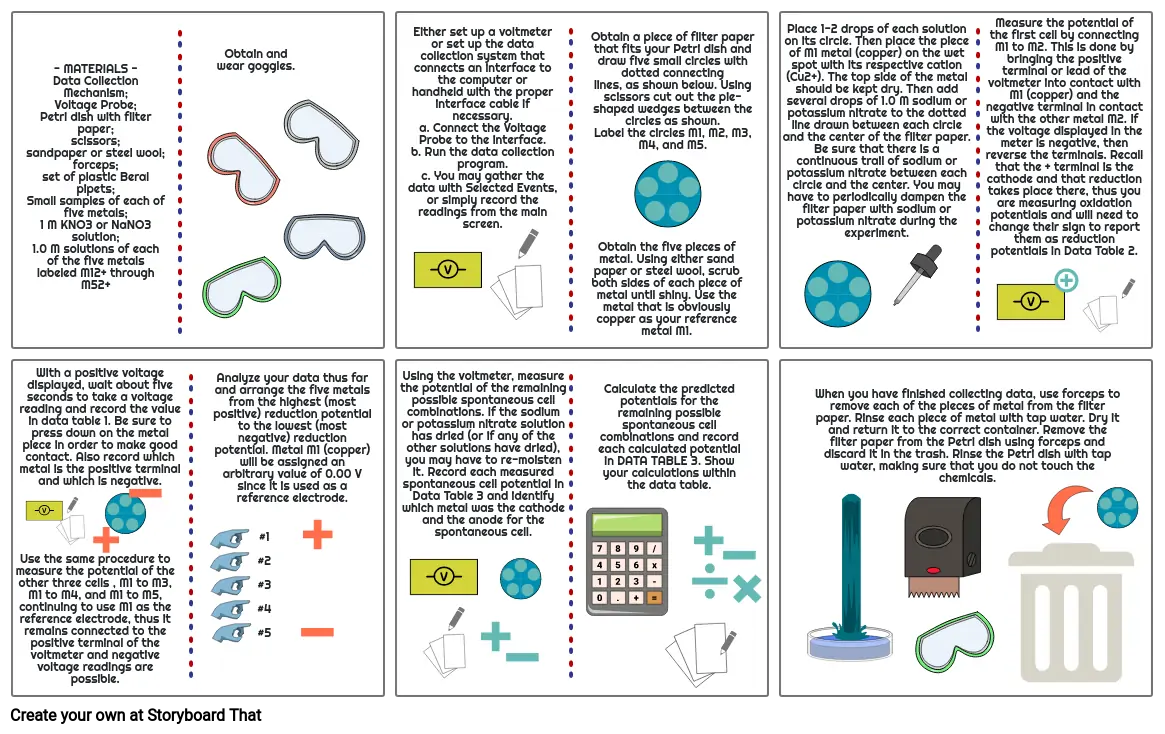Determination of an Electrochemical Series

Storyboard Text
- - MATERIALS -Data Collection Mechanism;Voltage Probe;Petri dish with filter paper;scissors;sandpaper or steel wool;forceps;set of plastic Beral pipets;Small samples of each of five metals;1 M KNO3 or NaNO3 solution;1.0 M solutions of each of the five metals labeled M12+ through M52+
- Obtain and wear goggles.
- Either set up a voltmeter or set up the data collection system that connects an interface to the computer orhandheld with the proper interface cable if necessary.a. Connect the Voltage Probe to the interface.b. Run the data collection program.c. You may gather the data with Selected Events, or simply record the readings from the main screen.
- Obtain the five pieces of metal. Using either sand paper or steel wool, scrub both sides of each piece ofmetal until shiny. Use the metal that is obviously copper as your reference metal M1.
- Obtain a piece of filter paper that fits your Petri dish and draw five small circles with dotted connectinglines, as shown below. Using scissors cut out the pie-shaped wedges between the circles as shown.Label the circles M1, M2, M3, M4, and M5.
- Place 1-2 drops of each solution on its circle. Then place the piece of M1 metal (copper) on the wet spot with its respective cation (Cu2+). The top side of the metal should be kept dry. Then add several drops of 1.0 M sodium or potassium nitrate to the dotted line drawn between each circle and the center of the filter paper. Be sure that there is a continuous trail of sodium orpotassium nitrate between each circle and the center. You may have to periodically dampen the filter paper with sodium or potassium nitrate during the experiment.
- Measure the potential of the first cell by connecting M1 to M2. This is done by bringing the positive terminal or lead of the voltmeter into contact with M1 (copper) and the negative terminal in contact with the other metal M2. If the voltage displayed in the meter is negative, then reverse the terminals. Recall that the + terminal is the cathode and that reduction takes place there, thus you are measuring oxidation potentials and will need to change their sign to report them as reduction potentials in Data Table 2.
- Use the same procedure to measure the potential of the other three cells , M1 to M3, M1 to M4, and M1 to M5, continuing to use M1 as the reference electrode, thus it remains connected to the positive terminal of the voltmeter and negative voltage readings are possible.
- With a positive voltage displayed, wait about five seconds to take a voltage reading and record the value in data table 1. Be sure to press down on the metal piece in order to make good contact. Also record which metal is the positive terminal and which is negative.
- Analyze your data thus far and arrange the five metals from the highest (most positive) reduction potential to the lowest (most negative) reduction potential. Metal M1 (copper) will be assigned an arbitrary value of 0.00 V since it is used as a reference electrode.
- #1#2#3#4#5
- Using the voltmeter, measure the potential of the remaining possible spontaneous cell combinations. If the sodium or potassium nitrate solution has dried (or if any of the other solutions have dried), you may have to re-moisten it. Record each measured spontaneous cell potential in Data Table 3 and identify which metal was the cathode and the anode for the spontaneous cell.
- Calculate the predicted potentials for the remaining possible spontaneous cell combinations and record each calculated potential in DATA TABLE 3. Show your calculations within the data table.
- When you have finished collecting data, use forceps to remove each of the pieces of metal from the filter paper. Rinse each piece of metal with tap water. Dry it and return it to the correct container. Remove the filter paper from the Petri dish using forceps and discard it in the trash. Rinse the Petri dish with tap water, making sure that you do not touch the chemicals.
Over 30 Million Storyboards Created

